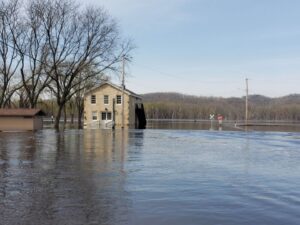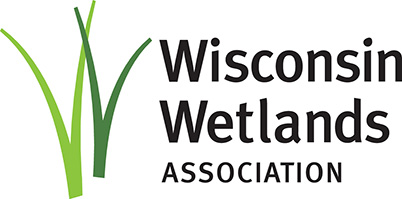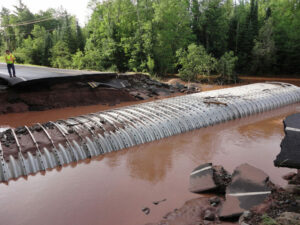By Lara Carlson, Legal Counsel for the Wisconsin Towns Association
This column is reprinted with permission from the Wisconsin Towns Association June 2023 magazine.
Wisconsin communities have experienced increasing numbers of historic “100-year” floods and storms in recent years. Flood damage threatens public health and safety, public infrastructure, homes, businesses, and natural habitats and is enormously costly to Wisconsin residents and communities. In the last 10 years, Wisconsin communities reported nearly $365 million in flood-related damages. During that time, 45 different Wisconsin counties have been included in disaster declarations, and multiple counties in the state have been impacted by 4 or more major flooding events. Local governments where these flooding events occur must figure out how to both respond to immediate public safety concerns and stretch already-squeezed budgets to cover the costs of replacing and repairing roads, bridges, and culverts year after year.
Currently, funding for flood mitigation projects to minimize these detrimental effects is extremely limited or non-existent. Most existing state and federal programs focus primarily on funding post-disaster efforts to replace, repair, or relocate structures damaged by flooding. Local government efforts are typically limited to patchwork road repairs and culvert replacements. This approach is proving to be ineffective in addressing the increasing magnitude of flooding and is both technically and financially unsustainable.
In response to these concerns, Representative Oldenburg and Senator Quinn recently introduced a bill, AB222/SB222, to create a pre-disaster flood resilience grant program. This bill focuses on proactive strategies that would empower Wisconsin communities to both better understand and identify flood risks and implement wetland and floodplain restoration projects to mitigate future flooding damages through natural flood management. The Wisconsin Towns Association spent months working with Representative Oldenburg and Senator Quinn, along with the Wisconsin Wetlands Association, Trout Unlimited, and other nonpartisan state organizations, to research and develop this proposed legislation. The resulting bill provides tools for local governments to address the root cause of flooding disasters rather than solely focusing on fixing and repairing damages after each incident.
The bill’s proposed grant program would be administered by the Wisconsin Emergency Management division of the Department of Military Affairs. Towns, villages, and other local government entities would be able to apply for flood vulnerability assessment grants of up to $300,000 and restoration implementation grants of up to $250,000. Grant eligibility would be based on whether a community is in an area of the state that was designated as a flood disaster or flood emergency area within the previous 10 years or whether the local government has a state-approved flood hazard mitigation plan in place.
The flood resilience grant program’s two-pronged approach addresses two ways in which current flood emergency response is lacking. First, this program encourages local governments to partner with others in an affected watershed to conduct broad-scale flood vulnerability assessments. Flood response typically focuses more narrowly on upgrading affected infrastructure, such as upsizing a particular culvert’s flow capacity, which can end up simply shifting the flooding problem further downstream. The assessments supported by this bill would instead evaluate flood vulnerability on a stream reach or watershed scale, collecting data on water flows, erosion hazards, and the condition and placement of culverts to determine the upstream causes of flooding and help local governments identify the most cost-effective solutions to reduce or prevent flooding damage altogether.

Villa Louis in Prairie du Chien, April 2023. Mississippi River flooding crested at 22.91 feet, the third highest crest on record for the area. Photo courtesy of the Wisconsin Historical Society.
Secondly, these grants would help local governments implement data-based flood mitigation strategies to proactively address flooding risks at their source. Grant funds could be used for design, engineering, construction, and post-construction monitoring of hydrologic restoration projects identified via a flood vulnerability assessment. Eligible projects would focus on restoring the landscape’s natural ability to store water and slow infiltration and runoff release, such as projects to reconnect streams and floodplains, reduce erosion hazards, reestablish vegetation, and remove or reduce wetland drainage. These practices could be combined with culvert upgrades and other structural improvements to assist the natural movement of water, sediment, and debris.
Natural flood management through hydrologic restoration improves the water retention already possible in existing, healthy wetlands and floodplains, allowing the land to capture, store, and slowly release vast quantities of water. One acre of wetlands can store a million or more gallons of water, providing an important buffer against flooding, contributing to keeping our drinking water clean, and acting as a critical source of habitat and food for Wisconsin wildlife. These benefits pay off downstream, as it’s easier for roads and culverts to manage the reduced flow of water and debris, mitigating the need for local governments to repeatedly pay to repair and replace infrastructure damaged by flooding.
The grant program established by AB222/SB222 will help local governments build resilience by improving our understanding of changing and growing flooding risks, leading to smarter, more cost-effective decisions about where to invest limited resources. Proactive efforts to reduce flood damages via improved data collection and hydrology-focused flood mitigation projects will save taxpayer money, improve public health and safety, preserve local government infrastructure, reduce economic disruption, and provide significant benefits to the quality and health of our state’s natural resources.
Related content
Wisconsin partners applaud action to fund the Pre-Disaster Resilience Grants
Wetlands and flood damages: Understanding the connections




